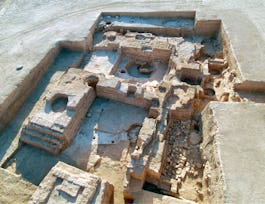Dinosaurs are unique in the history of life. They evolved more than 200 million years ago, inhabited every continent, and are still around today. This course provides an overview of the world of dinosaurs, from the earliest small dinosaurs to titanosaurs and T. rex to modern birds, and investigates some of the most fascinating questions in dinosaur paleontology: How did dinosaurs get so big? What were they like when they were alive? Why did they suddenly go extinct? Drawing on the Museum’s long-standing leadership in the field, including the world's largest collection of vertebrate fossils, renowned paleontologists Mark Norell and Diego Pol, joined by colleagues from around the world, explain how modern discoveries are made. Through videos and essays, this course takes learners into the field, where fossils are discovered and excavated, and then back to the lab where paleontologists use new technologies and methods to infer how these animals lived. Learners will do their own investigations using real specimens to gain first-hand knowledge of how paleontologists continue to make new discoveries about ancient creatures.



Dinosaurs: Evolution, Extinction, and Paleobiology

Instructor: Diego Pol
Sponsored by Louisiana Workforce Commission
(25 reviews)
Skills you'll gain
Details to know

Add to your LinkedIn profile
6 assignments
See how employees at top companies are mastering in-demand skills


Earn a career certificate
Add this credential to your LinkedIn profile, resume, or CV
Share it on social media and in your performance review

There are 6 modules in this course
We start with a few basic questions: What makes a dinosaur a dinosaur? How have dinosaurs inhabited our planet for hundreds of millions of years? How do we study them? Co-authors Dr. Mark Norell and Dr. Diego Pol kick off the course with three seminal essays. First, Pol provides a brief introduction to dinosaurs and their evolutionary context, from the Triassic period to today. Then Norell explains how he and other paleontologists discover fossil sites, excavate the specimens, and study them back at the American Museum of Natural History. A series of videos show scientists at work in the field and in the lab and provide a brief history of the Museum’s famous T. rex.
What's included
6 videos3 readings1 assignment
Dr. Diego Pol’s three essays explain how scientists map evolutionary changes through diagrams called phylogenetic trees in order to figure out how species are related to one another and when different traits emerged. He starts with an overview of the dinosaur family tree, highlighting the major groups and the features that distinguish them. Then he explains the basic evolutionary changes that occurred within each group over millions of years. And finally, he tells the exciting story of how he and colleagues discovered one of the largest dinosaurs that ever lived. Videos show how the titanosaur was discovered, prepared, and finally mounted at the American Museum of Natural History. This week's assignment gives learners the opportunity to examine the characteristics of a fossil and construct an evidence-based hypothesis for its phylogeny.
What's included
3 videos4 readings1 assignment
The three essays this week, written by Dr. Norell with guest author Dr. James Napoli, explain what extinct dinosaurs were like when they were alive: what they looked like, how they maintained their bodies, and how they used their senses. Norell and Napoli explain how these discoveries were made through modern paleontological techniques such as studying living analogues to make inferences about how extinct animals lived. Guest author Dr. Amy Balanoff presents a case study of Citipati osmolskae to illustrate how she and other paleontologists study the fossil skulls of ancient dinosaurs to hypothesize about dinosaur behavior. In this week’s video Norell and Balanoff discuss commonalities between living birds and their extinct ancestors. In this week’s assignment learners will observe trackways, collect data on foot length and stride length, and then make inferences about behavior from data analysis.
What's included
4 videos4 readings1 assignment
This week, four guest scientists share their research into how dinosaurs moved and reproduced. First, Dr. Matteo Fabbri explains how paleontologists draw on evidence from living birds and reptiles to infer how dinosaurs hatched and cared for their young. Then Dr. Jasmina Weimann takes us on her personal journey of discovery about the color of dinosaur eggshells. In the next essay, Dr. John Hutchinson explains how he examines fossil bones and trackways, and then uses computer models to hypothesize how dinosaurs walked and ran. And in the final essay, Dr. Emily Rayfield explains how she uses computational methods that apply physical principles to test and deduce the feeding behavior of non-avian dinosaurs. Videos help learners visualize what dinosaurs looked like and how they grew. In this week’s assignment, learners will use images of authentic growth rings to age dinosaurs and construct growth curves.
What's included
3 videos4 readings1 assignment
The guest author this week is Dr. Greg Erikson, a paleontologist who studies population biology, the field that addresses questions such as how long dinosaurs lived and when they reached reproductive age. The first essay picks up on the assignment from the previous week, explaining how scientists analyze patterns in bone growth to infer the age of a dinosaur when it died. The second essay explores how scientists use growth curves to explore how dinosaurs got so big, or so small. The third essay explains how we can obtain a clearer picture of how these animals lived by examining demographic data (i.e., how many dinosaurs lived together, how many were sexually mature, at what age they died). A video features Dr. Aki Watanabe discussing the lifespan and growth pattern of the famous T. rex, from fluffy chick to tyrant king.
What's included
3 videos3 readings1 assignment
In this final week of the course, learners will pivot from investigating how non-avian dinosaurs lived to exploring how they went extinct. In the first essay, Pol compares theories about what caused the great dinosaur extinction 66 million years ago. In the second essay, he digs deeper into that extinction event to address questions such as: Why did some animal species survive when so many others did not? In the final essay of the course, Dr. Pol answers the question: How do we know what we know about the K-T extinction, using the Tanis site in North Dakota as a case study to answer that question and more.
What's included
2 videos3 readings1 assignment
Instructor

Offered by
Why people choose Coursera for their career




Learner reviews
25 reviews
- 5 stars
84%
- 4 stars
16%
- 3 stars
0%
- 2 stars
0%
- 1 star
0%
Showing 3 of 25
Reviewed on Sep 27, 2024
Thoroughly enjoyed this course but bit confused as to why only one question for 5 out of the 6 assessments?
Recommended if you're interested in Physical Science and Engineering

Yale University

University of Arizona

Sapienza University of Rome

University of Alberta

Open new doors with Coursera Plus
Unlimited access to 10,000+ world-class courses, hands-on projects, and job-ready certificate programs - all included in your subscription
Advance your career with an online degree
Earn a degree from world-class universities - 100% online
Join over 3,400 global companies that choose Coursera for Business
Upskill your employees to excel in the digital economy


